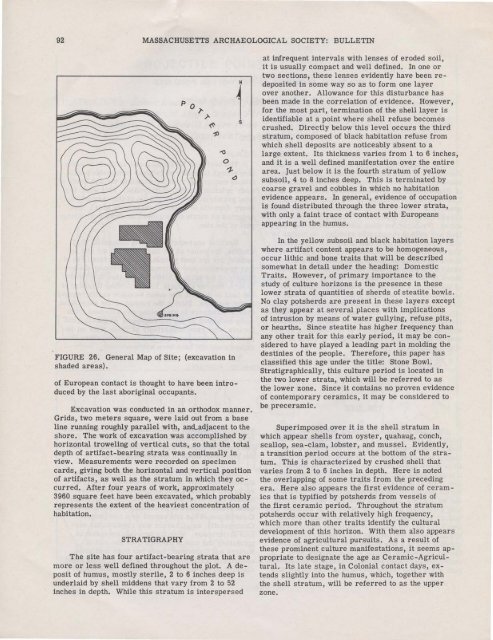Bulletin of the Massachusetts Archaeological Society, Vol. 11, No. 4 ...
Bulletin of the Massachusetts Archaeological Society, Vol. 11, No. 4 ...
Bulletin of the Massachusetts Archaeological Society, Vol. 11, No. 4 ...
Create successful ePaper yourself
Turn your PDF publications into a flip-book with our unique Google optimized e-Paper software.
92 MASSACHUSETTS ARCHAEOLOGICAL SOCIETY: BULLETIN<br />
FIGURE 26. General Map <strong>of</strong> Site; (excavation in<br />
shaded areas).<br />
<strong>of</strong> European contact is thought to have been introduced<br />
by <strong>the</strong> last aboriginal occupants.<br />
i s<br />
Excavation was conducted in an orthodox manner.<br />
Grids, two meters square, were laid out from a base<br />
line running roughly parallel with, ancLadjacent to <strong>the</strong><br />
shore. The work <strong>of</strong> excavation was accomplished by<br />
horizontal troweling <strong>of</strong> vertical cuts, so that <strong>the</strong> total<br />
depth <strong>of</strong> artifact-bearing strata was continually in<br />
view. Measurements were recorded on specimen<br />
cards, giving both <strong>the</strong> horizontal and vertical position<br />
<strong>of</strong> artifacts, as well as <strong>the</strong> stratum in which <strong>the</strong>y occurred.<br />
After four years <strong>of</strong> work, approximately<br />
3960 square feet have been excavated, which probably<br />
represents <strong>the</strong> extent <strong>of</strong> <strong>the</strong> heaviest concentration <strong>of</strong><br />
habitation.<br />
STRA TIGRAPHY<br />
The site has four artifact-bearing strata that are<br />
more or less well defined throughout <strong>the</strong> plot. A deposit<br />
<strong>of</strong> humus, mostly sterile, 2 to 6 inches deep is<br />
underlaid by shell middens that vary from 2 to 52<br />
inches in depth. While this stratum is interspersed<br />
at infrequent intervals with lenses <strong>of</strong> eroded soil,<br />
it is usually compact and well defined. In one or<br />
two sections, <strong>the</strong>se lenses evidently have been redeposited<br />
in some way so as to form one layer<br />
over ano<strong>the</strong>r. Allowance for this disturbance has<br />
been made in <strong>the</strong> correlation <strong>of</strong> evidence. However,<br />
for <strong>the</strong> most part, termination <strong>of</strong> <strong>the</strong> shell layer is<br />
identifiable at a point where shell refuse becomes<br />
crushed. Directly below this level occurs <strong>the</strong> third<br />
stratum, composed <strong>of</strong> black habitation refuse from<br />
which shell deposits are noticeably absent to a<br />
large extent. Its thickness varies from 1 to 6 inches,<br />
and it is a well defined manifestation over <strong>the</strong> entire<br />
area. Just below it is <strong>the</strong> fourth stratum <strong>of</strong> yellow<br />
subsoil, 4 to 8 inches deep. This is terminated by<br />
coarse gravel and cobbles in which no habitation<br />
evidence appears. In general, evidence <strong>of</strong> occupation<br />
is found distributed through <strong>the</strong> three lower strata,<br />
with only a faint trace <strong>of</strong> contact with Europeans<br />
appearing in <strong>the</strong> humus.<br />
In <strong>the</strong> yellow subsoil and black habitation layers<br />
where artifact content appears to be homogeneous,<br />
occur lithic and bone traits that will be described<br />
somewhat in detail under <strong>the</strong> heading: Domestic<br />
Traits. However, <strong>of</strong> primary importance to <strong>the</strong><br />
study <strong>of</strong> culture horizons is <strong>the</strong> presence in <strong>the</strong>se<br />
lower strata <strong>of</strong> quantities <strong>of</strong> sherds <strong>of</strong> steatite bowls.<br />
<strong>No</strong> clay potsherds are present in <strong>the</strong>se layers except<br />
as <strong>the</strong>y appear at several places with implications<br />
<strong>of</strong> intrusion by means <strong>of</strong> water gullying, refuse pits,<br />
or hearths. Since steatite has higher frequency than<br />
any o<strong>the</strong>r trait for this early period, it may be considered<br />
to have played a leading part in molding <strong>the</strong><br />
destinies <strong>of</strong> <strong>the</strong> people. Therefore, this paper has<br />
classified this age under <strong>the</strong> title: Stone Bowl.<br />
Stratigraphically, this culture period is located in<br />
<strong>the</strong> two lower strata, which will be referred to as<br />
<strong>the</strong> lower zone. Since it contains no proven evidence<br />
<strong>of</strong> contemporary ceramiCS, it may be considered to<br />
be preceramic.<br />
Superimposed over it is <strong>the</strong> shell stratum in<br />
which appear shells from oyster, quahaug, conch,<br />
scallop, sea-clam, lobster, and mussel. Evidently,<br />
a transition period occurs at <strong>the</strong> bottom <strong>of</strong> <strong>the</strong> stratum.<br />
This is characterized by crushed shell that<br />
varies from 2 to 6 inches in depth. Here is noted<br />
<strong>the</strong> overlapping <strong>of</strong> some traits from <strong>the</strong> preceding<br />
era. Here also appears <strong>the</strong> first evidence <strong>of</strong> ceram <br />
ics that is typified by potsherds from vessels <strong>of</strong><br />
<strong>the</strong> first ceramic period. Throughout <strong>the</strong> stratum<br />
potsherds occur with relatively high frequency,<br />
which more than o<strong>the</strong>r traits identify <strong>the</strong> cultural<br />
development <strong>of</strong> this horizon. With <strong>the</strong>m also appears<br />
evidence <strong>of</strong> agricultural pursuits. As a result <strong>of</strong><br />
<strong>the</strong>se prominent culture manifestations, it seems appropriate<br />
to designate <strong>the</strong> age as Ceramic-Agricultural.<br />
Its late stage, in Colonial contact days, extends<br />
slightly into <strong>the</strong> humus, which, toge<strong>the</strong>r with<br />
<strong>the</strong> shell stratum, will be referred to as <strong>the</strong> upper<br />
zone.
















